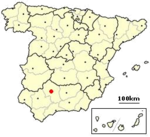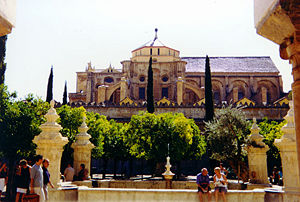Córdoba, Spain
|
||||||||||||||||||||||||||||||||||||||||||||||||||
|
||||||||||||||||||||||||||||||||||||||||||||||||||

On the Rio Guadalquivir, just downstream from the Puente Romano (Roman Bridge) is a restored Islamic water wheel that once would have raised water to the caliph's palace.
|
||||||||||||||||||||||||||||||||||||||||||||||||||
Cordova (Córdoba in Spanish, Arabic: قرطبة Qurṭuba)) is a city in Andalusia, southern Spain, and the capital of the province of Córdoba. Located at 37.88° North, 4.77° West, on the Guadalquivir river, it was founded in ancient Roman times as Corduba by Claudius Marcellus. Its population in 2007 was 323,600.[1]
Today a moderately-sized modern city, the old town contains many impressive architectural reminders of when Cordova was the thriving capital of the Caliphate of Cordova that governed almost all of the Iberian peninsula. It has been estimated that Cordova, with up to 500,000 inhabitants in the tenth century, was the largest city in Western Europe and, perhaps, in the world.[2]
Contents |
History

Cordova was the capital of the Roman province of Hispania Ulterior Baetica. Great philosophers like Lucius Annaeus Seneca the Younger, orators like Seneca the Elder and poets like Lucan expressed themselves in the palaces of Cordova. Later, it occupied an important place in the Provincia Hispaniae of the Byzantine Empire (552-572) and during the Visigoth period.
It was captured in 716 by the Muslims, and Cordova became capital during the Umayyad Caliphate, the period of its apogee, with a population ranging between 250,000 and 500,000 inhabitants. In the 10th century, Cordova – called قرطبة (Qurţuba) in Arabic – was one of the largest cities in the world, as well as a great cultural, political and economic centre. The Cordova Mosque dates back to this time. In 1236 it was captured by the king of Castile.
With one of the most extensive historical heritages in the world (declared a World Heritage Site by UNESCO December 17 1984), the city also features a number of modern areas, including the districts of Zoco and the railway station district, Plan RENFE.
The regional government (the Junta de Andalucía) has for some time been studying the creation of a Cordova Metropolitan Area that would comprise, in addition to the capital itself, the towns of Villafranca, Obejo, La Carlota, Villaharta, Villaviciosa, Almodóvar del Río. and Guadalcázar. The combined population of such an area would be around 351,000.
Geography
It's located on the banks of the Guadalquivir river and its easy access to the mining resources of the Sierra Morena (coal, lead, zinc) satisfy the population’s needs.
The city is located in a depression of the valley of the Guadalquivir. In the north is the Sierra Morena, which defines the borders of the municipal area.
Climate
Cordova has a Mediterranean climate with Atlantic coastal influences. Winters are mild with isolated frosts.
Summers, with increased daily thermal oscillations, have the highest maximum temperatures in Europe, exceeding 40 °C occasionally. Local minimum summer temperature is 27 °C, the highest in Spain and Europe. Precipitation is concentrated in the coldest months; this is due to the Atlantic coastal influence. Precipitation is generated by storms from the west that occur more often from December through February. This Atlantic characteristic then gives way to a hot summer with significant drought more typical of Mediterranean climates.
Annual rain surpasses 500 mm although there is a recognized inter-annual irregularity. In agreement with the Köppen climate classification, the local climate can be described as Csa.
Registered maximum temperatures at Cordova Airport (located at 6 km of the city) are 46.6° (23rd, July 1995) and 46.2° (1st, August 2003). The minimum temperature is -8.2° (28 January 2005).
Important buildings
Religious architecture
- The Great Mosque of Cordoba: The Mosque, which contains columns that date back to the Roman and Visigothic periods, was primarily constructed during the Umayyad period (its construction started in 784), and was converted to a Cathedral after the Reconquista.
- Synagogue (14th century)
- Fernandine- and Alphonsine-style churches (13th century)
- Various monasteries and convents
- The Walcha Cave, built in 1489.
Civil and military architecture
- Alcázar of the Christian Kings (14th century)
- Palace of Viana with its flowered patios (16th century)
- Royal residences and palaces
- The Tower of Calahorra (14th century)
- The Door of the Bridge (16th century)
- The Plaza Vieja or Plaza Mayor
- Walls and towers of the Muslim and also Christian period
Archaeological sites
- Roman archaeological remains (temple, mausoleum)
- Islamic archaeological remains (minarets preserved in the churches, Arab baths)
- Archaeological site of Madinat Al-Zahra (10th century)
- The Roman Bridge
Parks and Gardens
- Garden of the Victory
- Garden of the Rivas Duc
- Garden of the Agriculture
- Garden of the Conde de Vallellano
- Garden of Juan Carlos I
- Park Cruz Conde
- Sotos de la Albolafia
- Balcón del Guadalquivir
- Peri-urban park of Los Villares
- Park of the Miraflores
Famous people born in Cordova and its province
Cordova was the birthplace of five famous philosophers and religious scholars:
- In Roman times the Stoic philosopher Seneca,
- In classical Islamic times
- The Islamic scholar ibn Hazm, a major Muslim theologian and legal jurist,
- The Islamic scholar ibn Rushd or Averroes, one of Islam's most famous and eminent scholars and philosophers,
- Imam Abu 'Abdullah al-Qurtubi, a leading jurist of the Maliki madhab, and
- The Jewish rabbi and philosopher Moses Maimonides.
Cordova was also the birthplace of
- The Roman poet Lucan,
- The medieval Spanish poet Juan de Mena, and
- The Renaissance poet Luis de Góngora, who lived most of his life and wrote all his most important works but one in Cordova.
In addition some scholars have linked to Cordova
- The Renaissance philosopher Abraham Cohen de Herrera and
- The prominent Jewish mystic Moses ben Jacob Cordovero
Both of these were evidently descended from families which lived in Cordova before the expulsion of the Jews from Spain.
More recently, several flamenco artists were born here as well, including
- Fosforito,
- Paco Peña,
- Vicente Amigo, and
- Joaquín Cortés .
Twin cities
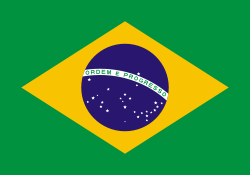 São Paulo, Brazil
São Paulo, Brazil Manchester, United Kingdom[3]
Manchester, United Kingdom[3] Bourg-en-Bresse, France
Bourg-en-Bresse, France Fes, Morocco[4]
Fes, Morocco[4]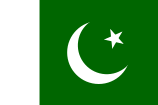 Lahore, Pakistan[4]
Lahore, Pakistan[4] Bethlehem, Palestinian Authority[5]
Bethlehem, Palestinian Authority[5]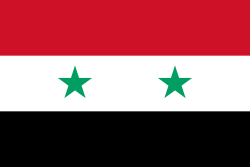 Damascus, Syria[4]
Damascus, Syria[4] Al Qayrawan, Tunisia[4]
Al Qayrawan, Tunisia[4] Adana, Turkey
Adana, Turkey Bukhara, Uzbekistan[4]
Bukhara, Uzbekistan[4]
References
- ↑ http://www1.ine.es/nomen2/index.do?accion=busquedaDesdeHome&nombrePoblacion=C%F3rdoba&x=13&y=8 Instituto Nacional de Estadística
- ↑ "geography.about.com".
- ↑ Corporaciones locales españolas hermanadas con Europa - Federación Española de Municipios y Provincias
- ↑ 4.0 4.1 4.2 4.3 4.4 La Cooperación Directa en el Ayuntamiento de Córdoba - Córdoba City Council Web
- ↑ The City of Bethlehem has signed a twinning agreements with the following cities Bethlehem Municipality.
External links
|
|||||||


